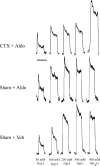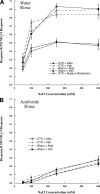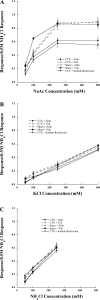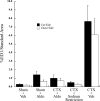Attenuation of peripheral salt taste responses and local immune function contralateral to gustatory nerve injury: effects of aldosterone
- PMID: 19675282
- PMCID: PMC2763818
- DOI: 10.1152/ajpregu.00219.2009
Attenuation of peripheral salt taste responses and local immune function contralateral to gustatory nerve injury: effects of aldosterone
Abstract
Dietary sodium restriction coupled with axotomy of the rat chorda tympani nerve (CTX) results in selectively attenuated taste responses to sodium salts in the contralateral, intact chorda tympani nerve. Converging evidence indicates that sodium deficiency also diminishes the activated macrophage response to injury on both the sectioned and contralateral, intact sides of the tongue. Because a sodium-restricted diet causes a robust increase in circulating aldosterone, we tested the hypothesis that changes in neurophysiological and immune responses contralateral to the CTX could be mimicked by aldosterone administration instead of the low-sodium diet. Taste responses in rats with CTX and supplemental aldosterone for 4-6 days were similar to rats with CTX and dietary sodium restriction. Responses to sodium salts were as much as 50% lower compared with sham-operated and vehicle-supplemented rats. The group-related functional differences were eliminated with lingual application of amiloride, suggesting that a major transduction pathway affected was through epithelial sodium channels. Consistent with the functional results, few macrophages were observed on either side of the tongue in rats with CTX and aldosterone. In contrast, macrophages were elevated on both sides of the tongue in rats with CTX and the vehicle. These results show that sodium deficiency or administration of aldosterone suppresses the immune response to neural injury, resulting in attenuation of peripheral gustatory function. They also show a potential key link among downstream consequences of sodium imbalance, taste function, and immune activity.
Figures





Similar articles
-
Injury-induced functional plasticity in the peripheral gustatory system.J Neurosci. 2002 Oct 1;22(19):8607-13. doi: 10.1523/JNEUROSCI.22-19-08607.2002. J Neurosci. 2002. PMID: 12351734 Free PMC article.
-
Up-regulation of activated macrophages in response to degeneration in the taste system: effects of dietary sodium restriction.J Comp Neurol. 2004 Nov 1;479(1):43-55. doi: 10.1002/cne.20307. J Comp Neurol. 2004. PMID: 15389612
-
Lipopolysaccharide-induced up-regulation of activated macrophages in the degenerating taste system.J Neurosci Res. 2005 Apr 1;80(1):75-84. doi: 10.1002/jnr.20438. J Neurosci Res. 2005. PMID: 15742361
-
Zinc deficiency enhances salt preference through altered peripheral and central taste processing mechanisms.J Oral Biosci. 2025 Mar;67(1):100627. doi: 10.1016/j.job.2025.100627. Epub 2025 Feb 5. J Oral Biosci. 2025. PMID: 39921163
-
The biopsychology of salt hunger and sodium deficiency.Pflugers Arch. 2015 Mar;467(3):445-56. doi: 10.1007/s00424-014-1676-y. Epub 2015 Jan 10. Pflugers Arch. 2015. PMID: 25572931 Free PMC article. Review.
Cited by
-
Aging profoundly delays functional recovery from gustatory nerve injury.Neuroscience. 2012 May 3;209:208-18. doi: 10.1016/j.neuroscience.2012.02.012. Epub 2012 Feb 21. Neuroscience. 2012. PMID: 22387273 Free PMC article.
-
Inflammatory stimuli acutely modulate peripheral taste function.J Neurophysiol. 2016 Jun 1;115(6):2964-75. doi: 10.1152/jn.01104.2015. Epub 2016 Mar 23. J Neurophysiol. 2016. PMID: 27009163 Free PMC article.
-
Shrinkage of ipsilateral taste buds and hyperplasia of contralateral taste buds following chorda tympani nerve transection.Neural Regen Res. 2015 Jun;10(6):989-95. doi: 10.4103/1673-5374.158366. Neural Regen Res. 2015. PMID: 26199619 Free PMC article.
-
Give-and-take of gustation: the interplay between gustatory neurons and taste buds.Chem Senses. 2024 Jan 1;49:bjae029. doi: 10.1093/chemse/bjae029. Chem Senses. 2024. PMID: 39078723 Free PMC article. Review.
-
Immune responses in the injured olfactory and gustatory systems: a role in olfactory receptor neuron and taste bud regeneration?Chem Senses. 2022 Jan 1;47:bjac024. doi: 10.1093/chemse/bjac024. Chem Senses. 2022. PMID: 36152297 Free PMC article. Review.
References
-
- Asher C, Eren R, Kahn L, Yeger O, Garty H. Expression of the amiloride-blockable Na+ channel by RNA from control versus aldosterone-stimulated tissue. J Biol Chem 267: 16061–16065, 1992 - PubMed
-
- Asher C, Wald H, Rossier BC, Garty H. Aldosterone-induced increase in the abundance of Na+ channel subunits. Am J Physiol Cell Physiol 271: C605–C611, 1996 - PubMed
-
- Bernstein IL, Taylor EM. Amiloride sensitivity of the chorda tympani response to sodium chloride in sodium-depleted Wistar rats. Behav Neurosci 106: 722–725, 1992 - PubMed
-
- Brown NJ. Aldosterone and vascular inflammation. Hypertension 51: 161–167, 2008 - PubMed
Publication types
MeSH terms
Substances
Grants and funding
LinkOut - more resources
Full Text Sources
Medical

